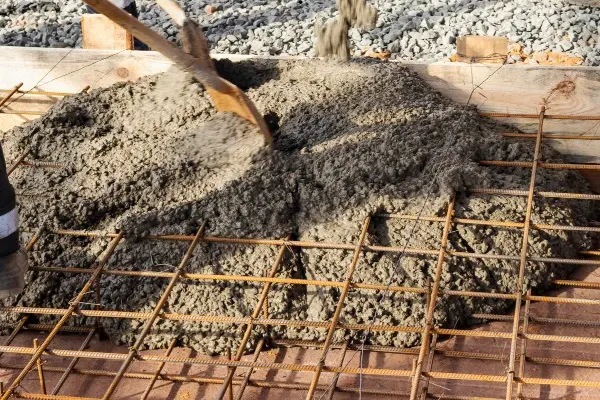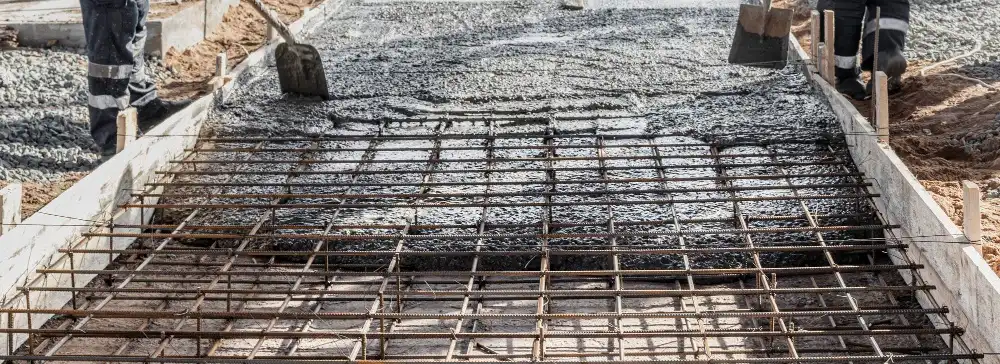The most widely used material in construction is concrete. It’s a mixer of cement, sand, aggregate, water and sometimes admixtures. It’s the most essential building material used in all types of construction projects, including homes, high-rise buildings, roads, dams, bridges, etc. Concrete can be moulded into a variety of shapes with the right formwork and is also available in many different types. But, reinforced cement concrete is the most popular type among all types of concrete.
Reinforced cement concrete (RCC) is an extensively used and adaptable building material that combines the flexibility and tensile strength of steel reinforcement with the strength of concrete. It has completely changed the way we construct buildings by providing a dependable and long-lasting solution for a variety of uses.
So, in this blog, Brick & Bolt provide a detailed guide on reinforced cement concrete, including what it is, types of reinforcement used in RCC, factors its uses, advantages and disadvantages, and the factors to consider before using rcc.
What is Reinforced Cement Concrete -RCC?
Reinforced cement concrete is made by combining concrete and steel bars, or reinforcement bars, the importance of reinforced cement concrete is RCC simultaneously support the tensile and compressive strength of the structure. Plain concrete cement is very strong in compression but weak in tension and has a low resistance to tension. Steel, on the other hand, is equally strong in both compression and tension, which is why plain concrete can only be used where the structural component is in pure compression. Therefore, steel and concrete work incredibly well together and are used to absorb all stresses.
Types of Reinforcement Used in RCC:
The following types of reinforcement are used to make reinforced cement concrete
1. Mild Steel Bars
Mild steel bars are generally bent easily without breaking at the bends. They are available in different diameters, but you have to check if they meet the requirements of the applicable codes regarding characteristic strength in tension.
2. Hot Rolled Bars
Hot rolled bars are specially prepared reinforcements. Compared to mild steel bars, their tension strength is nearly twice as high and is commonly available in thick sections. They can be bent without developing any defects when heated to up to 100°C, but using regular mild steel bars is not achievable.
3. Cold-Worked Bars
The cold-worked steel bars are formed into twisted or stretched shapes with long ribs or other structures running the length of them. Additionally, their characteristic strength is significantly higher than mild steel bars’, at approximately 425 N/mm2 instead of 250 N/mm2. These bars might not be heated in order to bend and re-bend.
4. Steel Fabric
Steel fabrics are made with different types of bars and wires such as indented and deformed wires, plain round wires, and deformed steel bars of cold-worked bars etc. These wires are made into mesh by carefully and strictly welding straightened lengths together in compliance with the specifications. If proper care should be not taken, there could be a negative impact on the mechanical characteristics of the reinforcement.
Uses of Reinforced Cement Concrete

RCC is the most practical and affordable material for various building applications, such as:
- Buildings
- Bridges
- Roads
- Water Tanks
- Flyovers
- Floating Structures
- Foundations
- Marine Structures
- Precast Works
- Bunkers and Silos
- Chimneys and Towers
- Pipes and Conduits
- Retaining Walls
Advantages of Reinforced Cement Concrete
The following are the advantages of reinforced cement concrete.
1. Strength
It is among the best building materials because of its excellent tension and compression strengths.
2. Durability
The RCC structures are long-lasting and durable. It can endure for up to 100 years and is not impacted by snow or rainfall. Because RCC has a low permeability, it can withstand substances like carbon dioxide, sulfates, and chlorides that dissolve in water without having significant deterioration.
3. Ductility
The reinforcement bar gives the ductility to the reinforced concrete structures. When reinforced concrete is overloaded, its ductility appears as distress in the form of cracks and deflection. This gives the engineers the opportunity to think of ways to prevent concrete damage to it.
4. Versatility
At the construction site, the concrete can be shaped into the desired shapes, forms, surfaces, textures, and sizes using shuttering or formwork configuration. When concrete is made, it is liquid, which makes it more suited for a variety of architectural needs.
5. Cost-Effective
The components of RCC are inexpensive and widely accessible worldwide. The cost of production is also extremely low. It is extensively utilized because reinforced concrete lasts a long time and requires less maintenance. In addition to being resilient and long-lasting, reinforced concrete uses less energy, resulting low operating costs of the structure.
6. Fire Resistance
No fire or burn occurs in the RCC. It can resist heat for a duration of two to six hours. Compared to other construction materials like steel and wood, reinforced concrete buildings have a higher fire resistance.
Disadvantages of Reinforced Cement Concrete
The following are the disadvantages of reinforced cement concrete:
- RCC structures are normally heavier than those made of steel, wood, or glass.
- Generally, RCC buildings require a lot of labour and site or workspace to fix because they require massive formwork, centring, and shuttering.
- It takes time for RCC to reach its maximum strength. Thus, it cannot be use right away after construction.
- Mixing, casting, and curing are the three primary steps to make reinforced concrete which all influence its ultimate strength.
- When compared to other methods, the forms needed for casting RCC are expensive.
- Strength loss and the formation of cracks are caused by shrinkage.
Factors To Consider Before Using RCC
To ensure the required quality, suitability, and cost-effectiveness, you should take these factors into account before using reinforced cement concrete for a construction project.
1. Requirement of Strength
Determine your requirement for the strength of the concrete according to the the intended use of the structure and design specifications. Take into account variables like structural stability, environmental conditions, and load-bearing capacity.
2. Quality Standards
Make sure the reinforced cement concrete fulfils all necessary quality standards and requirements. Hence, you have to verify that the manufacturer or supplier complies with strict quality control standards and holds the necessary certifications. By doing this, you can make sure that the concrete meets the required performance, strength, and durability requirements, guaranteeing a dependable and superior building material.
3. Mix Design
Understand the design of the concrete mix, including the amounts of water, admixtures, cement, sand and aggregates. Check whether the concrete mix design complies with the needs and specifications of your project. Think about the important factors like desired strength, workability, and setting time.
4. Source of Materials
Examine the source and quality of the major ingredients like aggregates, reinforcement, and cement which are used in making reinforced cement concrete. To increase the overall quality of the concrete, make sure you get these materials from reliable suppliers and that they meet all relevant quality standards.
Conclusion
In conclusion, this comprehensive guide to reinforced cement concrete (RCC) offers an in-depth understanding of its benefits, uses, disadvantages, and the factors to be considered before use. Because of its strength, durability, and versatility, reinforced cement concrete is frequently used by construction professionals in a variety of structures and projects. In contrast, They can ensure the long-term durability, structural integrity, and overall success of construction projects by putting best practices in reinforced cement concrete construction into practice.

